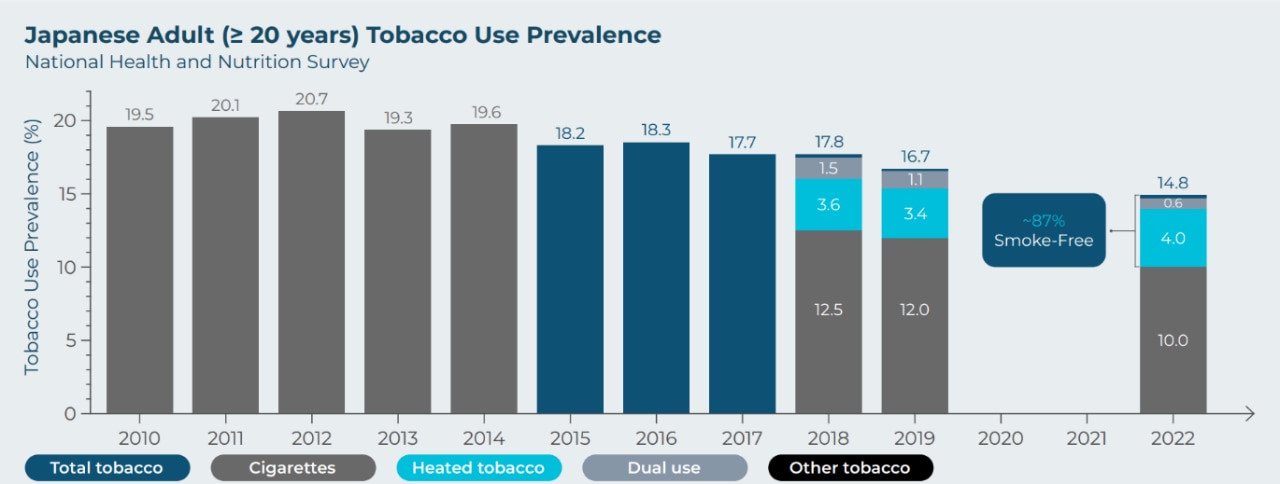The story of Tobacco Heating System in Japan
What impact did the introduction of THS have on tobacco harm reduction in Japan?
In 2000, approximately 33% of all adults in Japan smoked cigarettes. But in 2015, during and after the nationwide introduction of HTPs (THS was first released in Nagoya in 2014), sales of cigarettes began declining five times faster than in preceding years, an average annual decline of 9.5%, according to a study conducted by Stoklosa et al. When we look at the data ourselves, we can also clearly see that, after HTPs became available, sales of all tobacco products (including both HTPs and conventional cigarettes) continued to fall.
Data from the 2019 Japanese National Health and Nutrition Survey (NHNS), an annual nationwide health examination survey carried out under the Japanese Ministry of Health, Labour and Welfare (MHLW), indicated that 16.7% of adults surveyed used a tobacco product at that time. Of these, approximately 12% smoked cigarettes exclusively, about 3.4% used HTPs exclusively, and around 1.1% were dual users.
Published in 2024, data from the 2022 Japanese NHNS (data from 2020 and 2021 are not available as the two surveys were not conducted during the pandemic) confirmed a continued decline in cigarette smoking from the previous survey, with 14.8% of adults surveyed using a tobacco product at that time. Of these, 10% were exclusive cigarette smokers, 4% exclusive HTP users, and 0.6% dual users. Overall, the results indicate a 46% decrease in cigarette smoking since the introduction of HTPs (which include THS), from 19.6% of adults in 2014 to 10.6% (exclusive cigarette users plus dual users) in 2022.

Data from independent studies indicate that HTP use in Japan has also had a minimal impact on unintended users—nonsmokers, former smokers, and adolescents. One study from 2021 found daily heated tobacco product use among 12-18 years of 0.0% for those in junior high school and 0.1% in high school. Philip Morris International's (PMI's) own research has found that initiation rates among adult never tobacco users with THS were ≤0.1%, suggesting that nearly all THS users were cigarette smokers when they started using THS.
What impact did the introduction of HTPs have in Japan?
The experience and data from Japan show that smoke-free products can play a significant role in tobacco harm reduction and public health. Sales and prevalence data from Japan continue to show that HTPs have had a positive impact on decreasing smoking prevalence by transitioning a large number of adult smokers away from smoking cigarettes at a fast pace. The uptake of HTPs in Japan, accompanied by regulatory changes, has resulted in sharp declines in cigarette sales. Since 2015, Japan has seen a continued decline in smoking prevalence, which seems to be correlated with the introduction of heated tobacco products.
What research has PMI conducted in Japan?
PMI has conducted several important research studies in Japan to assess the impact of THS use in real-life settings on users and bystanders. One of these was a passive exposure study which exposed nonsmokers to THS aerosol in a restaurant in Tokyo. Urine samples were taken before and after exposure to determine the presence of harmful chemicals in the body. The results showed that THS use didn't generate environmental smoke and had no adverse effects on the indoor air quality. Additionally, nonsmokers didn't have an increase in exposure to nicotine and tobacco-specific nitrosamines (TSNA) as a result of passive exposure to the THS aerosol.
PMI has also conducted repeated cross-sectional surveys as part of the scientific assessment of THS. These used probability sampling representative of the general adult population in selected countries to estimate use prevalence of tobacco and nicotine-containing products, including HTPs, after the launch of THS in those countries. Surveys were also conducted among THS users associated with our THS owner databases, to provide complementary insights. In Japan specifically, PMI surveys on the usage prevalence and patterns of tobacco products among the general adult population (aged 20 and older) have been ongoing since 2016.
When looking at the usage of tobacco products in our studies, we see similar patterns to those described in the yearly NHNS. These studies also indicate that, while the prevalence of heated tobacco product use is increasing, overall tobacco product consumption is not.
What do independent researchers say about heated tobacco/THS?
Independent studies have also confirmed the rapid drop in cigarette sales in Japan following the initial introduction of THS in 2014, including four important studies carried out under the MHLW of Japan and its affiliated institutions.
In a reduced emission study published in the Journal of University of Occupational and Environmental Health, Japan (UOEH), the National Institute of Public Health (NIPH) concluded that “The concentrations of nicotine in tobacco fillers and the mainstream smoke of IQOS were almost the same as those of conventional combustion cigarettes, while the concentration of TSNAs was one fifth and CO [carbon monoxide] was one hundredth of those of conventional combustion cigarettes.”
The MHLW and the National Cancer Center (NCC) conducted two studies to examine the impact of HTPs on indoor air quality. They found that the “Exposure to aerosol from HTPs in a designated smoking room under usual conditions is estimated to be tolerable since the lifetime cancer risk is expected to be below a VSD [virtually safe dose] of 10-5 (1/100,000), which is three orders of magnitude lower than that for cigarettes smoked under the same conditions.”
Research by the Health Service Division of the MHLW, published in the International Journal of Environmental Research and Public Health, compared the concentration of nicotine and particulate matter (PM2.5, particles that are 2.5 microns or less in diameter) in the air following 50 puffs from HTPs or cigarettes in a small shower cubicle. They found that the “results do not negate the inclusion of HTPs within a regulatory framework for indoor tolerable use from exposure to HTP aerosol, unlike cigarette smoke.”
Finally, research data from Tottori University commissioned by MHLW demonstrates low levels of HTP use by young people, both in absolute and relative terms, compared with cigarettes.
The future of tobacco harm reduction
Japanese adult smokers’ acceptance of HTPs has shown that providing adult smokers with scientifically substantiated smoke-free alternatives to cigarettes can help reduce smoking prevalence, which can have potential benefits on public health.
Other countries are also considering the role of HTPs in tobacco harm reduction. For example, Public Health England has stated, “Alternative nicotine delivery devices, such as nicotine vaping products, could play a crucial role in reducing the enormous health burden caused by cigarette smoking.” Similarly, the U.S. Food and Drud Administration (FDA) has established the Modified Risk Tobacco Products pathway which allows companies a way to gain authorization for commercialization of novel tobacco products, including smoke-free products, with health-related claims that differentiate them from combustible products.
These regulatory frameworks not only promote innovation but also emphasize the importance of consumer awareness and education in transitioning adult smokers who would otherwise continue to smoke to potentially less harmful alternatives. As countries grapple with the complexities of tobacco control measures, collaboration among governments, health organizations, and the tobacco industry will be vital in shaping effective harm reduction strategies and policies.


Read the Scientific Update magazine
The Scientific Update magazine is focused on PMI's research and development efforts, milestone studies, industry regulations, and more. View the latest issue, or read the articles online.


